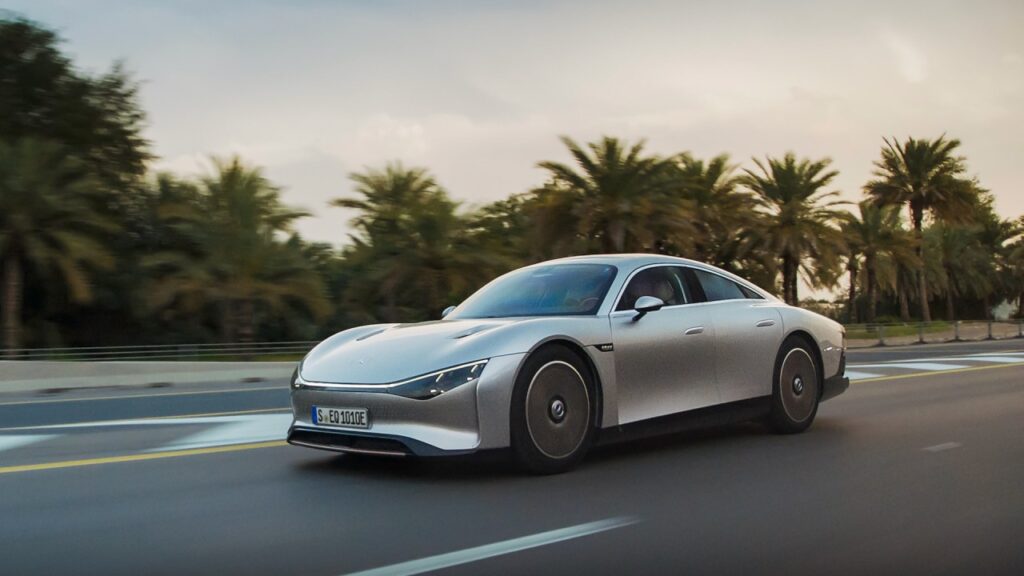Mercedes VISION EQXX Drives 1,010 km On Single Charge, Still Has 309 km Range Left
Mercedes-Benz is on an efficiency-demonstration spree with its VISION EQXX project achieving new records every day! The Mercedes VISION EQXX achieved a 1,010 km (627.6 mi.) range on a single charge and still had 309 km (192 mi.) of range in the tank. The German luxury carmaker is hyper-focused on achieving unprecedented levels of efficiency with its VISION EQXX concept. This is its third long (1,000 km+) and arduous journey across treacherous terrains to put the EV and its components through their paces. Prior to this, it had already successfully concluded a 1,000 km+ journey across Europe. This time around, the location – Arabian Peninsula, is a bit more extreme. This odyssey took place between Riyadh and Dubai in 14 hours and 42 minutes. The trip included urban and sub-urban sections with heavy traffic and lengthy highway sections across the open desert. You might also like: 2024 Mercedes EQS and EQE Get All-New Braking, More Range Mercedes VISION EQXX Achieves Incredible Range As per the official press release by Mercedes-Benz, the stunning test vehicle displayed an impressive power consumption of 7.4 kWh / 100 km (8.4 mi / kWh). This is an equivalent of approximately 0.9 l / 100 km or 282 MPGe for a gasoline vehicle. This test took place in an ambient temperature range of upto 34 degrees Celsius (93 degrees Fahrenheit). Note that the VISION EQXX boasts a drag coefficient of 0.17. On this momentous occasion, Markus Schäfer, Chief Technology Officer at Mercedes-Benz Group AG, said, “With an exceptional consumption of just 7.4 kWh/100 km, the VISION EQXX continues to provide valuable data for ongoing development of advanced electric efficiency technologies. As expected, all systems performed perfectly in the desert conditions, handling challenges such as road surface finish and temperature as well as dust with ease. Further proof that electric drive is ready for global markets.” You might also like: Mercedes, BMW Exceed EPA Range in Real-World Test, Tesla Falls Short Thermal Management and Solar Roof The VISION EQXX has showcased its capability by covering over 1,000 km on a single charge twice before. In its third road trip, reaching up to 34 degrees Celsius, the car’s advanced thermal management system was tested in desert conditions. An on-demand system efficiently regulated the electric drivetrain and cabin temperatures, while the air conditioning system, aided by a multi-source heat pump, operated with minimal energy impact. Engineers also evaluated the performance of the solar roof, equipped with 117 solar cells, harvesting 1.8 kWh of energy during the drive to Dubai, extending the range by approximately 24 km (15 mi.). Data on wind and sunlight influence, including angle and direction, were collected for comparative analysis with previous tests. Integration of such technology into the Concept CLA Class signifies broader applications within the Mercedes-Benz Modular Architecture (MMA) framework. You might also like: Taycan Turbo GT Becomes The Most Powerful Porsche Ever Learn Electric Cars Says This electric mobility revolution relies heavily on the efficiency of the powertrain. It includes electric motors, as well as a battery management system. Combine that with engineering to enhance the aerodynamics and auxiliary components like a multi-source heat pump, it is possible to maximize the range quite steeply. Agreed, this is not an inexpensive affair. In fact, that is why only premium carmakers are experimenting with it. Still, with time, these aspects of technology will trickle down to the mass market EVs.


